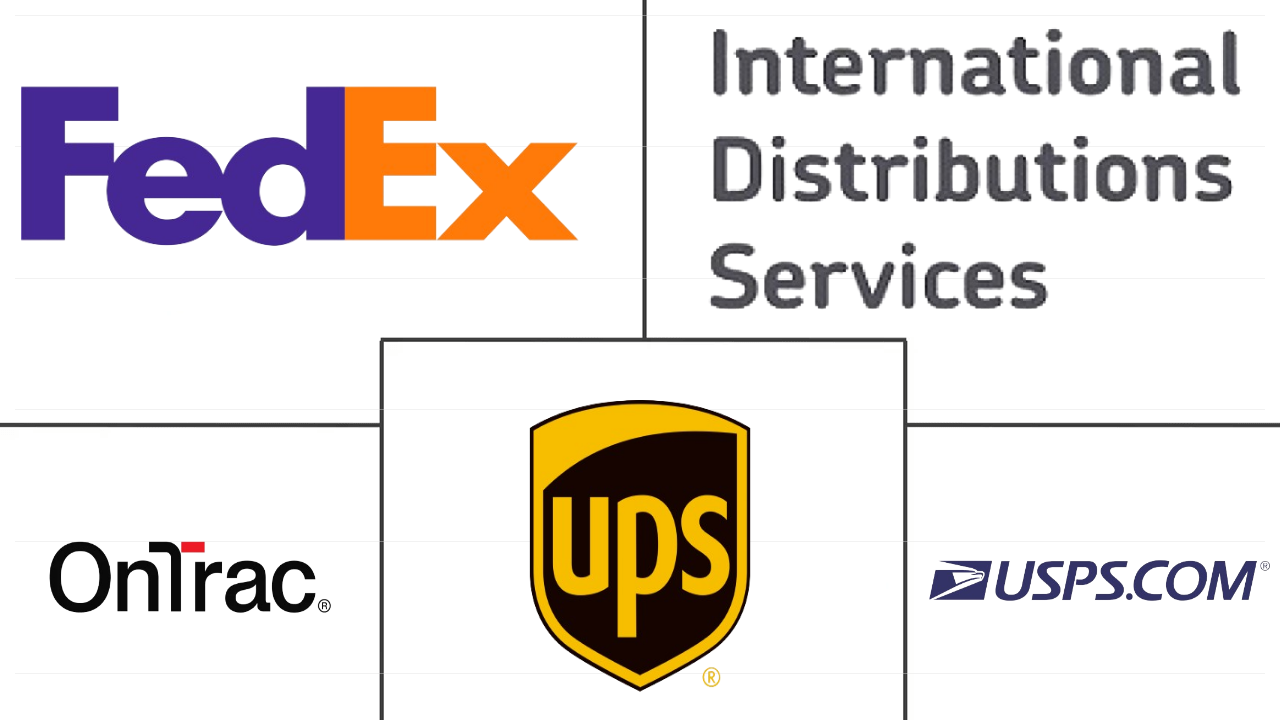Market Size of united states domestic courier Industry
|
|
Study Period | 2017 - 2030 |
|
|
Market Size (2024) | USD 140.60 Billion |
|
|
Market Size (2030) | USD 182.00 Billion |
|
|
Largest Share by End User Industry | E-Commerce |
|
|
CAGR (2024 - 2030) | 4.40 % |
|
|
Fastest Growing by End User Industry | E-Commerce |
Major Players |
||

|
||
|
*Disclaimer: Major Players sorted in no particular order |
United States Domestic Courier Market Analysis
The United States Domestic Courier Market size is estimated at 140.60 billion USD in 2024, and is expected to reach 182.00 billion USD by 2030, growing at a CAGR of 4.40% during the forecast period (2024-2030).
140.60 Billion
Market Size in 2024 (USD)
182.00 Billion
Market Size in 2030 (USD)
3.39 %
CAGR (2017-2023)
4.40 %
CAGR (2024-2030)
Fastest Growing Market by End User Industry
4.79 %
Projected CAGR, E-Commerce, 2024-2030
Top e-commerce players in the country are establishing intricate nationwide delivery networks and transporting and delivering more volume of goods.
Fastest Growing Market by Shipment Weight
4.53 %
Projected CAGR, Light Weight Shipments, 2024-2030
About more than half of the revenue share of the pharmaceutical industry is generated from domestic demand, wherein pharmaceutical e-commerce has been a growth catalyst.
Largest Market by Shipment Weight
77.37 %
value share, Light Weight Shipments, 2023
About 69.16% of the revenue share of the US pharmaceutical industry is generated from domestic demand, which significantly boosts the domestic courier market.
Largest Market by End User Industry
41.90 %
value share, E-Commerce, 2023
The growing B2C e-commerce market in the country is the major catalyst for the domestic courier market's growth.
First leading Market player
50.27 %
market share, United Parcel Service of America, Inc. (UPS), Inc. (UPS)

UPS delivers ground packages in the United States with an average daily package volume of more than 17 million. It has 1,000 package operating facilities in the United States.
The domestic courier market in the United States is expected to grow driven by rising e-commerce
- The surging demand for domestic courier delivery services in the healthcare sector is poised for significant growth in the coming years, propelled by the emergence and adoption of advanced technologies such as artificial intelligence and blockchain. In the US market, the healthcare end-user segment is anticipated to demonstrate a robust CAGR of 12.90% between 2023 and 2027. Consequently, the healthcare segment is projected to achieve a notable CAGR during the forecast period spanning from 2023 to 2028.
- In 2022, the industry saw a rise in partnerships between banks and courier companies, such as the collaboration between Oracle, JPMorgan Chase, and FedEx. This partnership aimed to introduce innovative cloud-driven B2B commerce services, facilitating seamless end-to-end transaction integration and automation. Oracle's B2B commerce platform was designed to seamlessly integrate with JPMorgan's extensive suite of payment services, including treasury services, trade, commercial cards, and travel cards. Additionally, the collaboration included plans to integrate logistics services as part of the FedEx-compatible program.
- Consumers are making more online purchases due to e-commerce expansion and the COVID-19 pandemic, fueling the parcel delivery market. The e-commerce sector in the US is forecasted to experience a robust CAGR of 11.22% from 2023 to 2027. The substantial internet and smartphone penetration rates in the country present e-commerce companies with significant opportunities to tap into this expanding market segment. As a result, the domestic courier market in the United States is expected to grow during the forecast period.
United States Domestic Courier Industry Segmentation
Express, Non-Express are covered as segments by Speed Of Delivery. Heavy Weight Shipments, Light Weight Shipments, Medium Weight Shipments are covered as segments by Shipment Weight. E-Commerce, Financial Services (BFSI), Healthcare, Manufacturing, Primary Industry, Wholesale and Retail Trade (Offline), Others are covered as segments by End User Industry. Business-to-Business (B2B), Business-to-Consumer (B2C), Consumer-to-Consumer (C2C) are covered as segments by Model.
- The surging demand for domestic courier delivery services in the healthcare sector is poised for significant growth in the coming years, propelled by the emergence and adoption of advanced technologies such as artificial intelligence and blockchain. In the US market, the healthcare end-user segment is anticipated to demonstrate a robust CAGR of 12.90% between 2023 and 2027. Consequently, the healthcare segment is projected to achieve a notable CAGR during the forecast period spanning from 2023 to 2028.
- In 2022, the industry saw a rise in partnerships between banks and courier companies, such as the collaboration between Oracle, JPMorgan Chase, and FedEx. This partnership aimed to introduce innovative cloud-driven B2B commerce services, facilitating seamless end-to-end transaction integration and automation. Oracle's B2B commerce platform was designed to seamlessly integrate with JPMorgan's extensive suite of payment services, including treasury services, trade, commercial cards, and travel cards. Additionally, the collaboration included plans to integrate logistics services as part of the FedEx-compatible program.
- Consumers are making more online purchases due to e-commerce expansion and the COVID-19 pandemic, fueling the parcel delivery market. The e-commerce sector in the US is forecasted to experience a robust CAGR of 11.22% from 2023 to 2027. The substantial internet and smartphone penetration rates in the country present e-commerce companies with significant opportunities to tap into this expanding market segment. As a result, the domestic courier market in the United States is expected to grow during the forecast period.
| Speed Of Delivery | |
| Express | |
| Non-Express |
| Shipment Weight | |
| Heavy Weight Shipments | |
| Light Weight Shipments | |
| Medium Weight Shipments |
| End User Industry | |
| E-Commerce | |
| Financial Services (BFSI) | |
| Healthcare | |
| Manufacturing | |
| Primary Industry | |
| Wholesale and Retail Trade (Offline) | |
| Others |
| Model | |
| Business-to-Business (B2B) | |
| Business-to-Consumer (B2C) | |
| Consumer-to-Consumer (C2C) |
United States Domestic Courier Market Size Summary
The United States Domestic Courier Market is experiencing a dynamic transformation, driven by the increasing demand for efficient delivery services across various sectors, particularly healthcare and e-commerce. The integration of advanced technologies such as artificial intelligence and blockchain is expected to significantly enhance service delivery and operational efficiency. The healthcare sector, in particular, is poised for substantial growth, with a strong focus on leveraging these technologies to streamline logistics and improve service offerings. The expansion of e-commerce, accelerated by the COVID-19 pandemic, has further fueled the demand for domestic courier services, as consumers increasingly turn to online shopping. This trend is supported by the high penetration rates of the internet and smartphones in the country, providing e-commerce companies with ample opportunities to expand their reach and enhance their service capabilities.
The market landscape is characterized by a high level of consolidation, with major players like FedEx, UPS, and USPS dominating the scene. Strategic partnerships and expansions, such as those between Oracle, JPMorgan Chase, and FedEx, are indicative of the industry's shift towards cloud-driven solutions and integrated logistics services. These collaborations aim to streamline B2B commerce and enhance transaction automation, reflecting the broader trend of digital transformation within the sector. Additionally, infrastructure investments, such as the US government's allocation of federal spending towards transportation and port development, are set to bolster the capabilities of the courier market. These initiatives are designed to improve supply chain reliability, increase port capacity, and create new job opportunities, thereby supporting the overall growth trajectory of the domestic courier market in the United States.
United States Domestic Courier Market Size - Table of Contents
-
1. MARKET SEGMENTATION (includes Market Value in USD, Forecasts up to 2030 and analysis of growth prospects)
-
1.1 Speed Of Delivery
-
1.1.1 Express
-
1.1.2 Non-Express
-
-
1.2 Shipment Weight
-
1.2.1 Heavy Weight Shipments
-
1.2.2 Light Weight Shipments
-
1.2.3 Medium Weight Shipments
-
-
1.3 End User Industry
-
1.3.1 E-Commerce
-
1.3.2 Financial Services (BFSI)
-
1.3.3 Healthcare
-
1.3.4 Manufacturing
-
1.3.5 Primary Industry
-
1.3.6 Wholesale and Retail Trade (Offline)
-
1.3.7 Others
-
-
1.4 Model
-
1.4.1 Business-to-Business (B2B)
-
1.4.2 Business-to-Consumer (B2C)
-
1.4.3 Consumer-to-Consumer (C2C)
-
-
United States Domestic Courier Market Size FAQs
How big is the United States Domestic Courier Market?
The United States Domestic Courier Market size is expected to reach USD 140.60 billion in 2024 and grow at a CAGR of 4.40% to reach USD 182.00 billion by 2030.
What is the current United States Domestic Courier Market size?
In 2024, the United States Domestic Courier Market size is expected to reach USD 140.60 billion.

